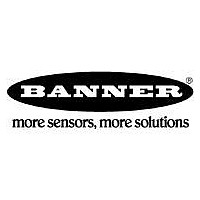T186EQ BANNER ENGINEERING, T186EQ Datasheet - Page 3

T186EQ
Manufacturer Part Number
T186EQ
Description
Photoelectric Sensor
Manufacturer
BANNER ENGINEERING
Type
Opposed Moder
Specifications of T186EQ
Output Current
150mA
Supply Voltage Range Dc
10V To 30V
Sensor Input
Optical
Sensing Range Max
20m
Contact Current Max
150mA
Switch Terminals
Quick Connect
Brand/series
T18
Current, Switching
150 mA
Humidity
90% (Max.) @ 50°C
Ip Rating
IP69K
Length, Cable
6.5 ft.
Light Source
Infrared LED
Material, Housing
PBT Polyester
Material, Lens
Polycarbonate⁄Acrylic
Mounting Type
Threaded
Primary Type
Photoelectric
Range, Measurement
66 mm
Response Time
3 ms (ON), 1.5 ms (OFF)
Sensing Mode
Opposed
Standards
UL Listed, CSA Recognized, CE Marked
Technology
Photoelectric
Temperature, Operating
-40 to +70 °C
Termination
4-Wire Connector
Voltage, Supply
30 VDC
Lead Free Status / Rohs Status
RoHS Exempt Product
Banner Engineering Corp. • Minneapolis, MN U.S.A
www.bannerengineering.com • Tel: 763.544.3164
The object then reflects the R1 and R2 fields equally, resulting in no false triggering. A better
solution, if possible, may be to reposition the object or the sensor.
Color Sensitivity
The effects of object reflectivity on cutoff distance, though small, may be important for some
applications. It is expected that at any given cutoff setting, the actual cutoff distance for lower
reflectance targets will be slightly shorter than for higher reflectance targets (see Figure-of-
Merit information on page 5). This behavior is known as color sensitivity.
For example, an excess gain of 1 (see page 5) for an object that reflects 1/10 as much light as
the 90% white card is represented by the horizontal graph line at excess gain = 10. An object
of this reflectivity results in a far limit cutoff of approximately 20 mm (0.8"), for the 25 mm (1")
cutoff model for example; thus 20 mm represents the cutoff for this sensor and target.
These excess gain curves were generated using a white test card of 90% reflectance.
Objects with reflectivity of less than 90% reflect less light back to the sensor, and thus
require proportionately more excess gain in order to be sensed with the same reliability as
more reflective objects. When sensing an object of very low reflectivity, it may be especially
important to sense it at or near the distance of maximum excess gain.
Figure 3. Reflective background – problem
Figure 5. Object beyond cutoff – problem
R1 = Near Detector
R2 = Far Detector
E
T18FF
A reflective background object in this position or
moving across the sensor face in this axis and
direction may cause false sensor response.
= Emitter
T18FF
R1 = Near Detector
R2 = Far Detector
E
= Emitter
R2
R1
E
R2
R1
T18 Sensors — dc-Voltage Series
E
Core of
Emitted
Beam
Sensing
Sensing
Fixed
Field
Fixed
Field
Strong
Direct
Reflection
to R1
Distance
Cutoff
Distance
Cutoff
Moving Object
Reflective
Reflective
Background
Surface
or
Figure 6. Object beyond cutoff – solution
Figure 4. Reflective background – solution
R1 = Near Detector
R2 = Far Detector
E
A reflective background object in this position or
moving across the sensor face in this axis will be
ignored.
T18FF
T18FF
= Emitter
R1, R2, E
R1 = Near Detector
R2 = Far Detector
E
= Emitter
R1
R2
E
Core of
Emitted
Beam
Fixed Sensing
Sensing
Field
Fixed
Field
P/N 121526 rev. A
Cutoff
Distance
Distance
Cutoff
Strong
Direct
Reflection
Away
From Sensor
Moving Object
Reflective
Background
Reflective
Surface
or
3









